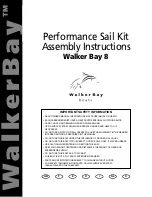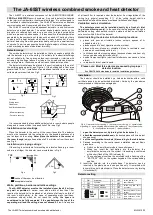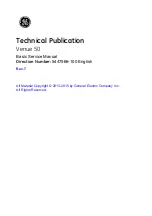
18
perfusion, and immediately increase the speed to reach target flow when cardioversion is complete.
Anticoagulation
Generally, no anticoagulation therapy is used in the first 6 to 24 hours after initiation of support due to usual postoperative
bleeding. Cases where CPB was not used prior to initiation of support, and bleeding is minimal, low dose anticoagulation with
heparin should be started sooner. Pump thrombosis may be minimized by maintaining flow of at least 3.0 LPM. Intravenous heparin
is usually started after the chest tube drainage is less than 50 ml/hour for at least 2 to 3 hours. The initial target ACT is 160-180
seconds, the target PTT is 1.3-1.6 times the laboratory normal, or the anti-Xa assay shows 0.3-0.7 IU/mL.
As anticoagulation and hemostasis may be affected by end organ function, platelet levels, platelet function, CentriMag system flow,
native cardiac output, and other factors, anticoagulation must be individualized for each patient by the attending physicians.
CAUTION: Monitor and administer anticoagulation carefully, as risk of bleeding or thrombosis may occur with inappropriate
management.
Heparin-induced thrombocytopenia is a complication of heparin therapy that presents with bleeding and consumption of platelets.
Treatment for HIT consists of withholding or reversing heparin. Aspirin, bivalirudin, warfarin, and a variety of other anticoagulants may
be considered as alternatives to heparin, depending on clinical objectives, experience at the individual center, and hepatic and/or
renal function.
Existing institutional protocols for managing HIT should be implemented as appropriate. A hematology consult can also
be valuable in the management of these patients.
Thromboelastography is used by some centers for the management of anticoagulation. Its use for VAD patients is not universally
accepted, although some centers with TEG equipment, experienced personnel, and well-defined protocols have found it useful and
reliable. If TEG is used, teams should be trained to ensure consistent results. The TEG should be initially reviewed carefully every day to
assess antiplatelet needs until stable and satisfactory levels are achieved. Anticoagulation needs vary by patient and should be adjusted
based on clinical judgment.
Wound Care
If the cannulas are tunneled, postoperative wound care should be consistent with standard surgical protocols. A standard occlusive
dressing should be used at the surgical sites to minimize the risk of infection. Cannula exit sites should be under a separate dressing
from the chest tube exit sites if possible.
Aseptic technique should be used by all staff when handling the surgical sites during dressing changes and other wound care. The
importance of consistent hand washing practices by staff and caretakers cannot be overemphasized. Wound sites should be carefully
inspected for signs of tissue breakdown or excessive drainage. Undue pressure or torque to the surgical site should be avoided in order to
minimize trauma with special care to secure the wound site taken during patient ambulation or transportation.
Nutrition
Enteral or parenteral feeding should be implemented when feasible during support. It is important that patients who achieve
explantation receive proper nutritional education from the hospital nutritionist to optimize recovery.
Physical Therapy
When feasible, the patient should receive passive and active range of motion physical therapy as tolerated. Some patients have also been
able to ambulate during CentriMag system support.
Should ambulation be considered, care must be taken to protect the cannulas, tubing and pump from any kinks or tension on the
circuit. It is advisable to ensure additional securing features (i.e., bands) on all connection sites of the circuit. Furthermore, if
ambulation is considered ensure that there is an appropriate number of staff available to monitor and support both patient and
circuitry. Before movement of the patient or circuit, inspect all connections of the circuit to be sure they are intact.
CAUTION: Ensure that the length of the tubing is adequate for ambulation to avoid the risk of disconnection, cannula
migration, or dislodgement.
Bedside range of motion or other light exercise is possible with extreme care, and useful for patients on support for multiple weeks.
Patient Transport
In some cases, a patient on CentriMag system support may need to be transported to another location within the hospital or to another
medical center. The CentriMag system meets international standards for air and ground transport and is designed for ease of use during
transport between medical centers. The system has been designed for portability in acute and critical care situations.
When transporting a patient within the hospital, consider the following:
Care must be taken to avoid dislodgement or disconnection of the cannula and tubing connections.
The pump and motor unit should be on a stable cart or placed in the bed with the patient and secured, or placed in the
CentriMag system transporter which has been attached to the bed.
If the motor is placed on the patient’s bed, the cable length from the console to the motor is usually sufficient to transport the
console on its cart alongside of the patient’s bed.
If the motor is placed on the patient’s bed, ensure that the pump and tubing are visible at all times. If necessary, the console can
be detached from its cart and placed on the bed. Because of the weight of the motor and the console, these items should not be
placed on top of the patient.
The motor, when operating, is warm to the touch. A barrier between the motor and the patient can be used to ensure that heat
from the motor does not come in contact with the patient’s skin.
CAUTION: Do not cover the motor or console with blankets to prevent them from overheating.
















































